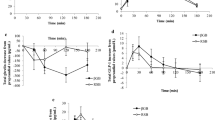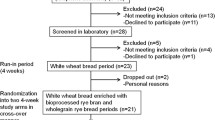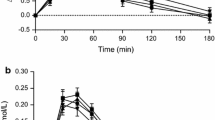Abstract
Sourdough bread has been reported to improve glucose metabolism in healthy subjects. In this study postprandial glycaemic and insulinaemic responses were evaluated in subjects with impaired glucose tolerance (IGT) who had a meal containing sourdough bread leavened with lactobacilli, in comparison to a reference meal containing bread leavened with baker yeast. Sixteen IGT subjects (age range 52–75, average BMI 29.9 ± 4.2 kg/m²) were randomly given a meal containing sourdough bread (A) and a meal containing the reference bread (B) in two separate occasions at the beginning of the study and after 7 days. Sourdough bread was leavened for 8 h using a starter containing autochthonous Saccharomyces cerevisiae and several bacilli able to produce a significant amount of d-and l-lactic acid, whereas the reference bread was leavened for 2 h with commercial baker yeast containing Saccharomyces cerevisiae. Plasma glucose and insulin levels were measured at time 0, 30, 60, 120, and 180 min. In IGT subjects sourdough bread induced a significantly lower plasma glucose response at 30 minutes (p = 0.048) and a smaller incremental area under curve (AUC) Δ 0–30 and Δ 0–60 min (p = 0.020 and 0.018 respectively) in comparison to the bread leavened with baker yeast. Plasma insulin response to this type of bread showed lower values at 30 min (p = 0.045) and a smaller AUC Δ 0–30 min (p = 0.018). This study shows that in subjects with IGT glycaemic and insulinaemic responses after the consumption of sourdough bread are lower than after the bread leavened with baker yeast. This effect is likely due to the lactic acid produced during dough leavening as well as the reduced availability of simple carbohydrates. Thus, sourdough bread may potentially be of benefit in subjects with impaired glucose metabolism.



Similar content being viewed by others
References
Tessier S, Gerber M (2005) Factors determining the nutrition transition in two Mediterranean islands: Sardinia and Malta. Public Health Nutr 8:1286–1292
Liljeberg HG, Lonner CH, Bjorck IM (1995) Sourdough fermentation or addition of organic acids or corresponding salts to bread improves nutritional properties of starch in healthy humans. J Nutr 125:1503–1511
Liljeberg H, Bjorck I (1994) Bioavailability of starch in bread products. Postprandial glucose and insulin responses in healthy subjects and in vitro resistant starch content. Eur J Clin Nutr 48:151–163
De Fronzo R, Ferrannini E (1991) Insulin resistance—a multifaceted syndrome responsible for NIDDM, obesity, hypertension, dyslipidemia, and artherioslerotic cardiovascular disease. Diabetes Care 14:173–194
Nijpels G (1998) Determinants for the progression from impaired glucose tolerance to non-insulin-dependent diabetes mellitus. Eur J Clin Invest 28(Suppl 2):8–13
Liljeberg HG, Akerberg AK, Björck IM (1999) Effect of the glycemic index and content of indigestible carbohydrates of cereal-based breakfast meals on glucose tolerance at lunch in healthy subjects. Am J Clin Nutr 69:647–655
Panagiotakos DB, Pitsavos C, Stefanadis C (2006) Dietary patterns: a Mediterranean diet score and its relation to clinical and biological markers of cardiovascular disease risk. Nutr Metab Cardiovasc Dis 16:559–568
Modan M, Harris MI, Halkin H (1989) Evaluation of WHO and NDDG criteria for impaired glucose tolerance. Results from two national samples. Diabetes 38:1630–1635
Catzeddu P, Mura E, Parente E, Sanna M, Farris GA (2006) Molecular characterization of lactic acid bacteria from sourdough breads produced in Sardinia (Italy) and multivariate statistical analyses of results. Syst Appl Microbiol 29:138–134
Corsetti A, Lavermicocca P, Morea M, Baruzzi F, Tosti N, Gobbetti M (2001) Phenotypic and molecular identification and clustering of lactic acid bacteria and yeasts from wheat (species Triticum durum and Triticum aestivum) sourdoughs of Southern Italy. Int J Food Microbiol 64:95–104
Damiani P, Gobbetti M, Cossignani L, Corsetti A, Simonetti MS, Rossi J (1996) The Sourdough microflora. Characterization of hetero- and homo-fermentative lactic acid bacteria, yeast and their interactions on the basis of the volatile compounds produced. Lebensm Wiss u Technol. 29:63–70
Foschino R, Terraneo R, Mora D, Galli A (1999) Microbial characterization of sourdoughs for sweet baked products. Ital J Food Sci 1:19–28
Gobbetti M, Corsetti A, Rossi J, La Rosa F, Dé Vincenzi S (1994) Identification and clustering of lactic acid bacteria and yeast from wheat sourdoughs of central Italy. Ital J Food Sci 1:85–94
Friedewald WT, Levy RI, Fredrickson DS (1972) Estimation of the concentration of low-density lipoprotein cholesterol in plasma, without use of the preparative ultracentrifuge. Clin Chem 18:499–502
Danilatos GD, Postle R (1982) The environmental scanning electron microscope and its applications. Scan Electron Microsc (Pt 1):1–16
Leroy F, De Winter T, Adriany T, Neysens P, De Vuyst L (2006) Sugars relevant for sourdough fermentation stimulate growth of and bacteriocin production by Lactobacillus amylovorus DCE 471. Int J Food Microbiol 112:102–11
Liljeberg HG, Bjorck IM (1996) Delayed gastric emptying rate as a potential mechanism for lowered glycemia after eating sourdough bread: studies in humans and rats using test products with added organic acids or an organic salt. Am J Clin Nutr 64:886–893
Liljeberg HG, Lonner CH, Bjorck IM (1995) Sourdough fermentation or addition of organic acids or corresponding salts to bread improves nutritional properties of starch in healthy humans. J Nutr 125:1503–1511
Östman EM, Nilson M, Liljeberg Elmståhl HGM, Molin G, Björck IME (2002) On the effect of lactic acid on blood glucose and insulin responses to cereals products: mechanistic studies in healthy subjects and in vitro. J Cereal Science 36:339–346
Östman EM, Liljeberg Elmståhl HGM, Björck IME (2002) Barley bread containing lactic acid improves glucose tolerance at a subsequent meal in healthy men and women. J Nutr 132:1173–1175
Gannon MC, Nuttall FQ, Krezowski PA, Billington CJ, Parker S (1986) The serum insulin and plasma glucose responses to milk and fruit products in type 2 (non-insulin-dependent) diabetic patients. Diabetologia 29:784–791
Östman EM, Liljeberg Elmståhl HGM, Björck IM (2001) Inconsistency between glycemic, insulinemic responses to regular and fermented milk products. Am J Clin Nutr 74:96–100
Frid AH, Nilsson M, Holst JJ, Björck IM (2005) Effect of whey on blood glucose and insulin responses to composite breakfast and lunch meals in type 2 diabetic subjects. Am J Clin Nutr 82:69–75
Nilsson M, Stenberg M, Frid AH, Holst JJ, Björck IM (2004) Glycemia and insulinemia in healthy subjects after lactose-equivalent meals of milk and other food proteins: the role of plasma amino acids and incretins. Am J Clin Nutr 80:1246–1253
Leeman M, Ostman E, Björck I (2005) Vinegar dressing and cold storage of potatoes lowers postprandial glycaemic and insulinaemic responses in healthy subjects. Eur J Clin Nutr 59:1266–1271
Ropert A, Cherbut C, Roze C, Le Quellec A, Holst JJ, Fu-Cheng X, Bruley des Varannes S, Galmiche JP (1996) Colonic fermentation and proximal gastric tone in humans. Gastroenterology 111:289–296
Jenkins DJA, Wolever TMS, Collier GR, Ocana A, Rao AV, Buckley G, Lam Y, Mayer A, Thompson LU (1987) Metabolic effects of a low glycemic-index diet. Am J Clin Nutr 46: 968–975
Polhill TS, Saad S, Poronnik P, Fulcher GR, Pollock CA (2004) Short-term peaks in glucose promote renal fibrogenesis independently of total glucose exposure. Am J Physiol Renal Physiol 287:F268–273
Home P (2005) Contributions of basal and post-prandial hyperglycaemia to micro- and macrovascular complications in people with type 2 diabetes. Curr Med Res Opin 21:989–998
Acknowledgments
We would like to thank Ms. Alba Canu from “Centro di Restauro Soprintendenza Beni Archeologici Province di Sassari e Nuoro” for her assistance in ESEM analysis, and Gloria Calì from the Westminster School of Sassari for her assistance in checking the manuscript.
Author information
Authors and Affiliations
Corresponding author
Rights and permissions
About this article
Cite this article
Maioli, M., Pes, G.M., Sanna, M. et al. Sourdough-leavened bread improves postprandial glucose and insulin plasma levels in subjects with impaired glucose tolerance. Acta Diabetol 45, 91–96 (2008). https://doi.org/10.1007/s00592-008-0029-8
Received:
Accepted:
Published:
Issue Date:
DOI: https://doi.org/10.1007/s00592-008-0029-8




